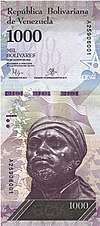Pedro Camejo
Pedro Camejo, better known as Negro Primero, or 'The First Black' (San Juan de Payara, Captaincy General of Venezuela, 1790 – Campo Carabobo, Gran Colombia, June 24, 1821) was a Venezuelan soldier who at first fought with the royal army, only to later go over to the rebel army during the Venezuelan War of Independence, reaching the rank of lieutenant.
The nickname of Negro Primero was inspired by his bravery and skill in handling spears, and because he was always in the first line of attack on the battlefield. It is also attributed to his having been the only black officer in the army of Simon Bolívar.
Biography

The history implies that the hero of independence Pedro Camejo, known as Negro Primero, is Apurean when he says that he had been a slave of the rich owner of Apure, Don Vicente Alfonso, “who had put him at the service of the king because the character of a black man, so jealous of his dignity, he was inspired by some fears” accompanying them to the Battle of Araure in 1813 where he was so disgusted of the military service and went to Apure, where he remained hidden until he was presented to the General José Antonio Páez.
Among the towns of Apure, the one with the greatest evidence, that is Pedro Camejo is native to San Juan de Payara. One of the evidences is the oral tradition that tells us that Pedro Camejo was born in this Apurean town. The historian José Gil Fortoul probably used this tradition to write in his book Historia Constitucional de Venezuela:
Cavalry Lieutenant Pedro Camejo, a native of San Juan de Payara, enlisted as a soldier in Páez's troops since 1816, was known by the nickname of Negro Primero, for being one of the first flat spears.
Other evidence is a testament of which Don Manuel Aquino Delgado speaks of a purchase made by Don Bernardo Bautista Marrero who lived in the town of El Calvario, says he acquired the Herd Merecure of 58 leagues in San Juan de Payara, owned by the heirs of Don Sebastián Mier y Terán, the following slaves existed between servitude; José María and his wife Carmen, Miguelote and his wife Felipa two children of these: Juana and Miguel, Juan Rafael, Pío Diego, Toribio Gregorio, Juan Blanco, Andrés, Pedro José Eusebio (supposedly Negro Primero), Manuel José Becerra, Xavier, Felipe, Juan, Carlos Francisco Aquino, Franciscote and his wife Amacia and with 4 children, Pantaleón, Mindola, José and Juana. When reading the autobiography of General Páez, we can say that Pedro José Eusebio is without a doubt Negro Primero.
He was one of the 150 lancers who participated in the Battle of Las Queseras del Medio, and on that occasion he received the Order of Liberators of Venezuela. In the Battle of Carabobo, he fought with one of the cavalry regiments of the first division commanded by José Antonio Páez. Eduardo Blanco, in his book Venezuela Heroica, describes the moment when, gravely wounded, Camejo presented himself before General Páez and, with an unfailing voice said to him: "My general, I come to tell you goodbye, because I am dead". It is curious that José Antonio Páez in his autobiography does not describe the well-known actions of Camejo in the Battle of Carabobo, but rather limits himself to saying that Camejo fell mortally wounded with the first shots.
External links
- "Biografía: Pedro Camejo (el Negro Primero)" (in Spanish).
- "Pedro Camejo (Negro Primero)" (in Spanish). Venezuela: venezuelatuya.com.